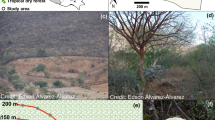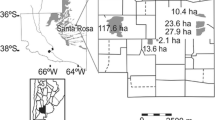Abstract
Predation rates of natural and artificial bird nests in rural landscapes have been the subject of numerous studies, often in the context of proximity to edge. Similar studies in urban and suburban landscapes are lacking. We carried out a study of egg and seed removal at forest reserve edges in three urban and two suburban forests in and near New York City in 1994-1995. Few significant edge effects were found, but this may have been because of the extraordinarily high rates of egg and seed removal. Daily removal rates were higher in suburban sites (eggs, 86%; seeds, 95%) than in urban sites (eggs, 64%; seeds, 88%). Exposed seeds and eggs suffered higher rates of removal than seeds and eggs covered by leaf litter. Despite statistically significant differences among treatments, all of these rates would be prohibitively high if experienced by ground-nesting birds or large-seeded trees (if removal was associated with predation). A survey of the literature suggests that egg predation rates are prohibitively high in cities and peak in suburban sites (at least in this study), then drop rapidly in ex-urban and rural sites, perhaps because of a similar pattern in the abundance of corvid bird predators.
Similar content being viewed by others
References
Alverson, W. S., Kuhlman, W. and Waller, D. M. (1994) Wild forests: conservation biology and public policy. Island Press, Washington, D.C.
Alverson, W. S., Waller, D. M. and Solheim, S. L. (1988) Forests too deer: edge effects in northern Wisconsin. Conserv.Biol. 2, 348–356.
Andren, H. (1992) Corvid density and nest predation in relation to forest fragmentation: a landscape perspective. Ecology 73, 794–804.
Andren, H. (1995) Effects of landscape composition on predation rates at habitat edges. In Mosaic landscapes and ecological processes (L. Hansson L. Fahrig and G. Merriam, eds), pp. 225–255. Chapman and Hall, London.
Andren, H. and Angelstam, P. (1988) Elevated predation rates as an edge effect in habitat islands: experimental evidence. Ecology 69, 544–547.
Blair, R. B. (1996) Land use and avian species diversity along an urban gradient. Ecol.Appl. 6, 506–519.
Bowers, M. A. and Breland, B. (1996) Foraging of gray squirrels on an urban-rural gradient: use of GUD to assess anthropogenic impact. Ecol.Appl. 6, 1135–1142.
Burkey, T. (1993) Edge effects in seed and egg predation at two neotropical rainforest sites. Biol.Conserv. 66, 139–143.
DeGraaf, R. M. and Angelstam, P. (1996) Effects of timber size-class on predation of artificial nests in extensive forest. Forest Ecol.Manag. 61, 127–136.
Emlen, J. T. (1974) An urban bird community in Tuscon, Arizona: derivation, structure, regulation. Condor 76, 184–197.
Gleason, H. A. and Cronquist, A. (1991) Manual of vascular plants of northeastern United States and adjacent Canada. The New York Botanical Garden, NY.
Guyn, K. L. and Clark, R. G. (1997) Cover characteristics and success of natural and artificial duck nests. J.Field Ornithol. 68, 33–41.
Hartley, M. J. and Hunter, M. L. (1996) Effects of landscape forest coverage on nest predation rates and edge effects: a synthesis. Bull.Ecol.Soc.Am.(Suppl.) 77, 185.
Haskell, D. G. (1995a) Forest fragmentation and nest predation – are experiments with Japanese quail eggs mis-leading? Auk 112, 767–770.
Haskell, D. G. (1995b) A reevaluation of the effects of forest fragmentation on rates of bird-nest predation. Conserv.Biol. 9, 1316–1318.
Haskell, D. G. (1996) Do bright colors at nests incur a cost due to predation? Evol.Ecol. 10, 285–288.
Matlack, G. R. (1993) Sociological edge effects – spatial distribution of human impact in suburban forest fragments. Environ.Manag. 17, 829–835.
McDonnell, M. J. and Pickett, S. T. A. (1991) Ecosystem structure and function along urban-rural gradients: an unexploited opportunity for ecology. Ecology 71, 1232–1237.
Murcia, C. (1995) Edge effects in fragmented forests – implications for conservation. Trends Ecol.Evol. 10, 58–62.
Myster, R. W. and Pickett, S. T. A. (1993) Effects of litter, distance, density and vegetation patch type on postdis-persal tree seed predation in old fields. Oikos 66, 381–388.
Nour, N., Matthysen, E. and Dhondt, A. A. (1993) Artificial nest predation and habitat fragmentation – different trends in bird and mammal predators. Ecography 16, 111–116.
Paton, P. W. C. (1994) The effects of edge on avian nest success: how strong is the evidence? Conserv.Biol. 8, 17–26.
Pouyat, R. V. and McDonnell, M. J. (1991) Heavy metal accumulations in forest soils along an urban-rural gradient in southeastern New York, USA. Water Air Soil Pollut. 57–58, 797—807.
Robinson, S. K., Thompson, F. R., Donovan, T. M., Whitehead, D. R. and Faaborg, J. (1995) Regional forest fragmentation and the nesting success of migratory birds. Science 267, 1987–1990.
Sodhi, N. S. (1992) Comparison between urban and rural bird communities in prairie Saskatchewan – urbanization and short-term population trends. Can.Field Nat. 10, 210–215.
Telleria, J. L. and Santos, T. (1992) Spatiotemporal patterns of egg predation in forest islands – an experimental approach. Biol.Conserv. 62, 29–33.
Vanderhaegen, W. M. and DeGraaf, R. M. (1993) Predation on artificial nests in forested riparian buffer strips. J.Wildl.Manag. 60, 542–550.
Wilcove, D. S., McLellan, C. H. and Dobson, A. P. (1986) Habitat fragmentation in the temperate zone. In Conservation biology (M. E. Soule, ed), pp. 237–256. Sinauer, Sunderland, Massachusetts.
Willebrand, T. and Marcstrom, V. (1988) On the danger of using dummy nests to study predation. Auk 105, 378–379.
Yahner, R. H. and Mahan, C. G. (1996) Depredation of artificial ground nests in a managed, forested landscape. Conserv.Biol. 10, 285–288.
Young, T. P. (1995) Landscape mosaics created by canopies gaps, forest edges, and bushland glades. Selbeyana 15, 127–134.
Zar, J. H. (1984) Biostatistical analysis. Prentice-Hall, Englewood Cliffs, New Jersey.
Author information
Authors and Affiliations
Rights and permissions
About this article
Cite this article
Russo, C., Young, T.P. Egg and seed removal at urban and suburban forest edges. Urban Ecosystems 1, 171–178 (1997). https://doi.org/10.1023/A:1018575527910
Issue Date:
DOI: https://doi.org/10.1023/A:1018575527910




